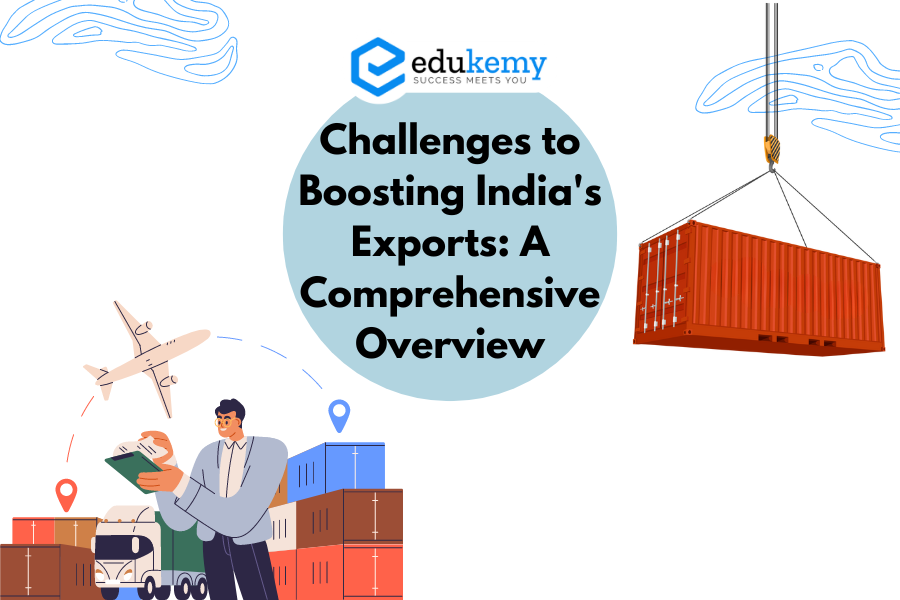
Boosting India’s exports stands as a pivotal ambition for the nation’s economic growth and global standing. However, this pursuit is not without its challenges, spanning from systemic issues to external factors. Understanding these hurdles is essential for devising effective strategies to propel India’s export sector forward. This comprehensive overview delves into the multifaceted challenges hindering India’s export growth, exploring both domestic constraints and global dynamics that shape the landscape of international trade. By dissecting these challenges, stakeholders can discern pathways to overcome obstacles and unlock the full potential of India’s export capabilities.
Contents
- 1 Global Challenges:
- 2 Domestic Challenges:
- 3 Conclusion:
- 4 FAQs
- 4.1 Q: What are some challenges hindering the growth of India’s exports?
- 4.2 Q: How does infrastructure pose a challenge to India’s export expansion?
- 4.3 Q: What role do regulatory procedures play in inhibiting India’s export potential?
- 4.4 Q: How does limited access to finance impact India’s export sector?
- 4.5 Q: What strategies can India adopt to overcome these export challenges?
- 5 In case you still have your doubts, contact us on 9811333901.
Global Challenges:
- Global Trade Slowdown:
- The overall slowdown in global trade poses a challenge, limiting the potential growth of India’s exports.
- External demand, a key driver of exports, is impacted by global economic conditions.
- Tariff Wars and Stability Threats:
- Ongoing tariff wars between major economies contribute to trade instability, affecting global supply chains.
- The uncertainty in trade policies can deter international business engagements.
- Multilateralism in Retreat:
- Retreat from multilateralism hampers the effectiveness of global trade agreements and collaborative efforts.
- Bilateral and regional approaches may not fully compensate for the benefits of multilateral agreements.
- Debates on Regional Trading Arrangements:
- The potential impact of regional trading arrangements, such as the RCEP (Regional Comprehensive Economic Partnership), is a subject of debate.
- Ensuring favorable terms within regional agreements requires strategic negotiation.
Domestic Challenges:
- Weak Infrastructure:
- Insufficient infrastructure, including ports, roads, and power facilities, hinders the smooth movement of goods.
- Infrastructure inadequacies contribute to delays and increase costs.
- High Transaction Costs:
- Procedural cumbersomeness and bureaucratic processes result in high transaction costs.
- Simplifying procedures and reducing red tape are essential for cost-effective trade operations.
- Skill Deficit:
- A deficit in skilled manpower poses challenges in meeting the demands of various industries.
- Addressing skill gaps is crucial for enhancing productivity and competitiveness.
- Rigid Labour Laws:
- The rigidity of existing labour laws can impede the flexibility required for dynamic business operations.
- Labor reforms are essential to create a conducive environment for both employers and employees.
- Tax Stability Post-GST:
- The introduction of GST (Goods and Services Tax) has brought changes to the tax landscape.
- Ensuring stability and addressing concerns related to GST implementation is vital for businesses.
Conclusion:
Navigating the complex landscape of global trade challenges requires a multi-faceted approach. Addressing domestic issues, improving infrastructure, reducing transaction costs, investing in skill development, and undertaking necessary reforms will contribute to enhancing India’s resilience and competitiveness in the global market. Additionally, fostering international collaborations and advocating for multilateralism can play a pivotal role in overcoming global challenges.
FAQs
Q: What are some challenges hindering the growth of India’s exports?
A: Several challenges impede India’s export growth, including infrastructural constraints, complex regulatory procedures, inadequate trade facilitation, limited access to finance, and stiff competition from other global players.
Q: How does infrastructure pose a challenge to India’s export expansion?
A: India’s inadequate infrastructure, encompassing transportation, logistics, and ports, hampers the efficient movement of goods, leading to delays, increased costs, and decreased competitiveness in the global market.
Q: What role do regulatory procedures play in inhibiting India’s export potential?
A: Complex and cumbersome regulatory procedures, such as compliance requirements, paperwork, and bureaucratic red tape, pose significant hurdles for exporters, leading to delays in shipments and increased transaction costs.
Q: How does limited access to finance impact India’s export sector?
A: Limited access to affordable credit and trade finance options constrains the ability of Indian exporters, especially small and medium enterprises (SMEs), to invest in technology, upgrade infrastructure, and explore new markets, thereby limiting their export potential.
Q: What strategies can India adopt to overcome these export challenges?
A: India can implement reforms to improve infrastructure, streamline regulatory procedures, enhance trade facilitation measures, increase access to finance for exporters, and focus on skill development and technology adoption to enhance competitiveness and boost exports. Additionally, fostering strategic partnerships and diversifying export destinations can help mitigate the risks associated with overreliance on specific markets.
In case you still have your doubts, contact us on 9811333901.
For UPSC Prelims Resources, Click here
For Daily Updates and Study Material:
Join our Telegram Channel – Edukemy for IAS
- 1. Learn through Videos – here
- 2. Be Exam Ready by Practicing Daily MCQs – here
- 3. Daily Newsletter – Get all your Current Affairs Covered – here
- 4. Mains Answer Writing Practice – here

